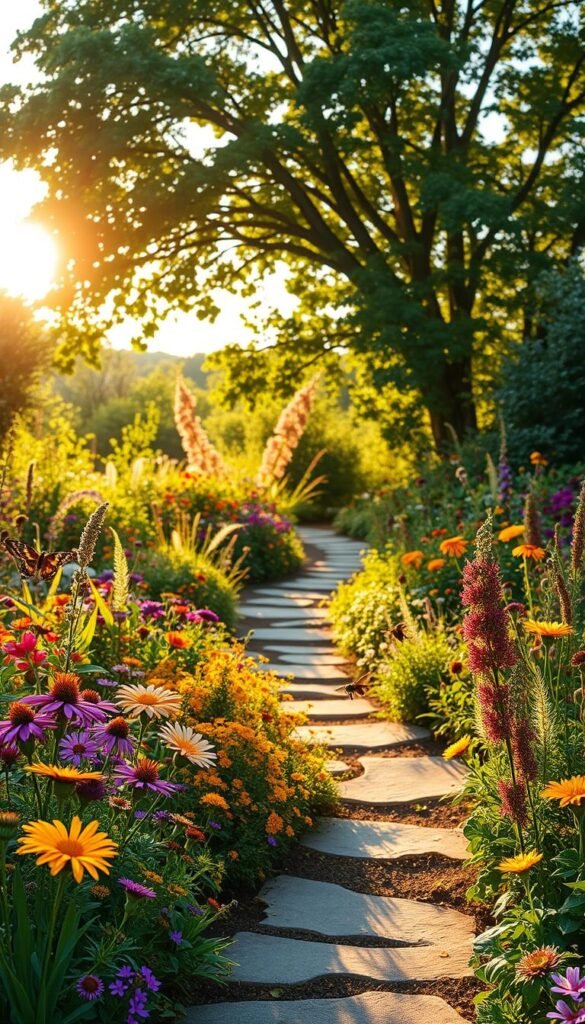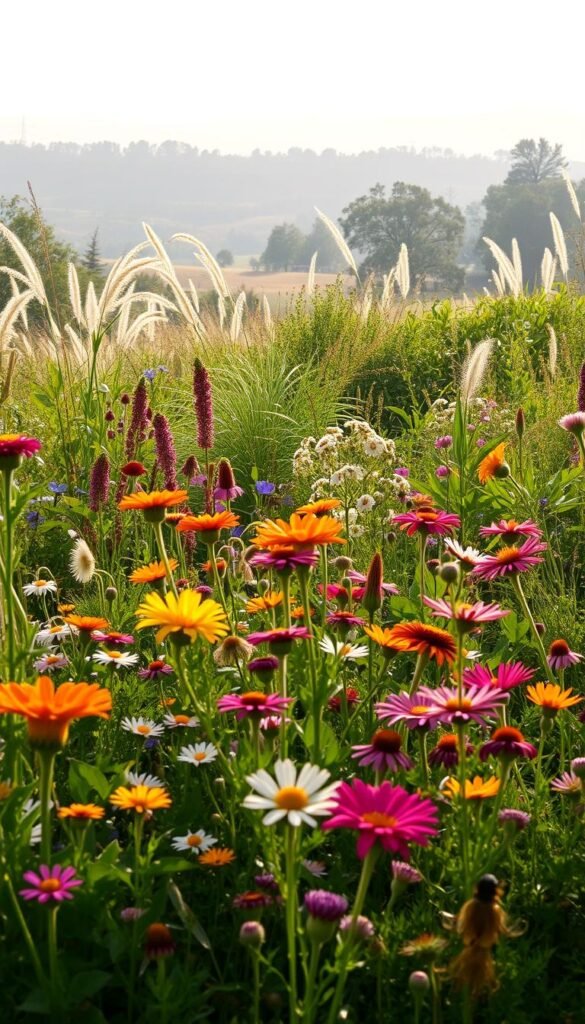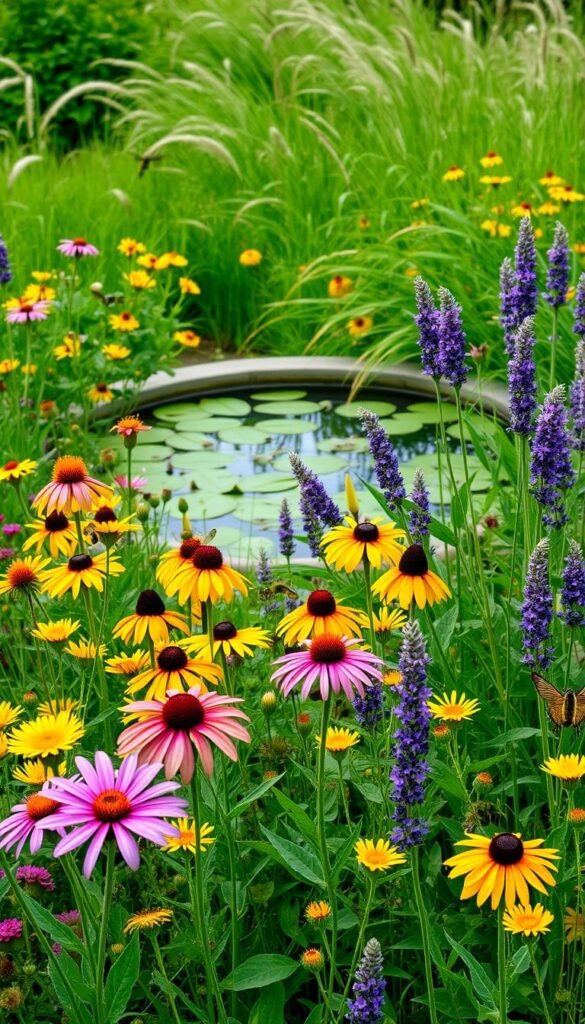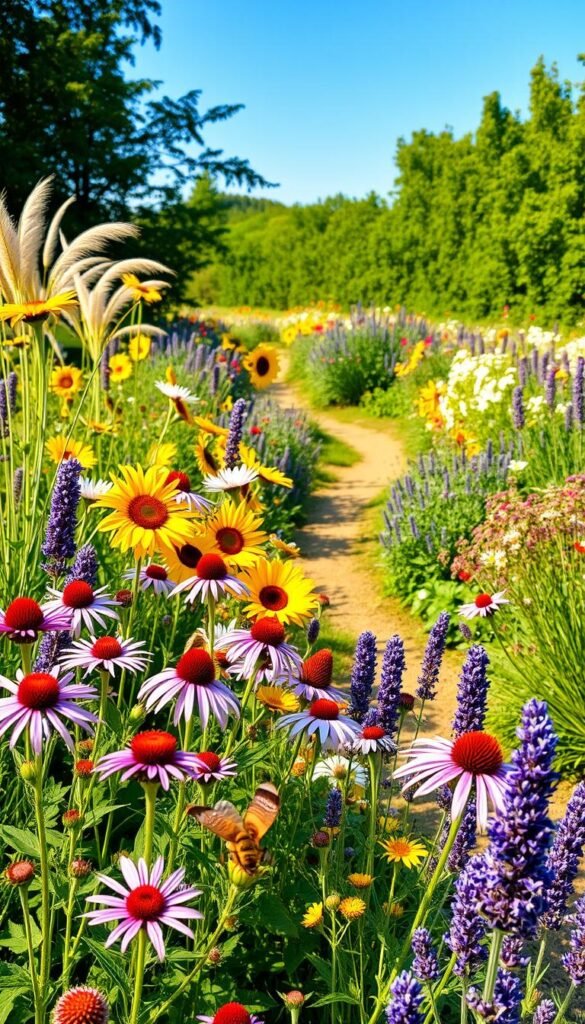Did you know your outdoor space—whether a balcony or backyard—holds power to revitalize local ecosystems? Pollinators like bees and butterflies drive biodiversity, yet their populations face steep declines. By designing spaces that welcome them, you become part of a solution with ripple effects far beyond your property.
The U.S. Fish and Wildlife Service calls these creatures the “engine of healthy habitats,” and it’s easier than you think to help. Even a few square feet of carefully chosen flowers can provide vital food and shelter. Unlike generic ornamentals, native species like milkweed and goldenrod evolved alongside local insects, offering perfect nutrition.
Your efforts connect to larger conservation wins. A Michigan schoolyard’s ladybug release cut pest damage by 60%, while urban balconies nationwide host thriving pollinator communities. Successful habitats prove every patch matters in rebuilding ecosystems.
We’ll guide you through selecting plants that bloom spring through fall, avoiding pesticides, and arranging clusters for easy foraging. You’ll learn how your garden supports food crops and wildlife while joining a movement restoring millions of acres. Let’s create spaces where nature—and you—can thrive.
Planning Your Pollinator Garden

Your journey begins with smart preparation. Like a roadmap for nature, thoughtful design ensures your green space becomes a buzzing hub of activity. Let’s break down the essentials for success.
Selecting the Ideal Location for Sun and Shade
Most pollinator-attracting plants crave sunlight. Butterflies need warm spots to rest, while bees prefer sunny areas for efficient foraging. Observe your yard for 2-3 days to track where sunlight lingers longest. Windy spots? Add shrubs like buttonbush as natural windbreaks.
Assessing Soil Type and Sunlight Exposure
Soil quality shapes your plant choices. Grab a handful of dirt—does it crumble (sandy) or clump (clay)? Sandy soils drain quickly, perfect for purple coneflower. Clay holds moisture, ideal for swamp milkweed. Pair this with native plant gardening knowledge to match species to your conditions.
Timing Your Garden: Seasonal Bloom Considerations
Follow the 3x3x3 rule: three plants blooming in spring (like wild lupine), three in summer (bee balm), and three in fall (goldenrod). This creates a non-stop buffet. Cluster same-species plants together—pollinators spot color blocks easier than scattered singles.
Even tricky spaces shine. Slopes reduce soil erosion, while small patios host potted natives. Document sunlight patterns hourly—full sun means 6+ hours daily. Partial sun? 3-6 hours works for asters. Your efforts today create thriving habitats tomorrow.
Building a Pollinator-Friendly Garden with Native Plant Species: Plant Selection and Planting Techniques

Transform your outdoor space into a buzzing sanctuary by selecting flora that works with your local ecosystem rather than against it. This phase turns plans into reality through thoughtful species choices and strategic layouts.
Choosing Native Plants That Thrive
Local species like purple coneflower and butterfly weed adapt naturally to your region’s climate. Always verify plants are pesticide-free—many big-box retailers treat stock with neonicotinoids harmful to insects. Connect with specialty nurseries through the step-by-step guide from wildlife experts.
Deciding Between Seeds and Nursery-Started Plants
Seeds save money but demand patience—scatter them in fall for spring growth. Potted plants offer instant impact, though costs add up. For new gardeners, try a mix: sow hardy species like milkweed from seed while buying delicate columbine as starters.
Arranging Patches for Continuous Bloom
Group three identical plants together, repeating this “triplet” pattern across seasons. Spring-blooming phlox feeds early bees, summer’s blazing star sustains butterflies, and autumn goldenrod preps pollinators for winter. This staggered approach ensures no hungry visitor leaves empty-handed.
Space plants according to mature sizes—crowding causes competition. Tall sunflowers belong behind compact asters. With smart placement, you’ll create both beauty and utility, proving even modest gardens can drive conservation.
Creating a Supportive Habitat for Pollinators

Your garden can become more than just a pretty space—it can be a lifesaving refuge for vital creatures. Let’s enhance your outdoor area with features that keep bees, butterflies, and other pollinators thriving year-round.
Constructing Bee Boxes and Nesting Sites
Turn scrap lumber into cozy condos for native bees. Drill 3-5″ deep holes of varying widths (1/8″ to 1/2″) in untreated wood. Mount these under eaves or on posts facing morning sun. Leave dead tree limbs (if safe) for cavity-nesting species—they’re nature’s original bee hotels!
Add damp soil patches near water sources. Mix sea salt into mud for butterfly mineral licks. A dripping hose creates perfect puddling spots where butterflies gather essential nutrients.
Incorporating Hummingbird Feeders and Nectar Resources
Attract flying jewels with homemade nectar: 4 parts water to 1 part white sugar. Never use honey or dyes—they harm hummingbirds. Clean feeders with hot soapy water every 3 days to prevent mold.
Include host plants like milkweed for monarch caterpillars. Accept chewed leaves as proof your garden supports full life cycles. Cluster these with nectar-rich blooms to create pollinator pit stops.
Rock piles and brush stacks offer shelter through seasons. These simple additions transform your space into a living habitat where every creature finds resources to survive and thrive.
Wrapping Up Your Native Plant Pollinator Garden Journey
Your green sanctuary becomes a living classroom where every bloom tells a story. Patience rewards you—milkweed might take two seasons to flower, while bees need time to discover new nectar sources. Track visitors with a journal: note which flowers attract the most butterflies or which shrubs shelter bird nests.
Stick to a simple care routine. Water deeply but infrequently to encourage strong roots. Pull weeds early, and mulch around plants to retain moisture. If pests appear, try soapy water sprays at dusk when pollinators rest. Always prioritize natural solutions over pesticides.
Connect with local gardening groups to swap seeds or share cuttings. Your single pot of goldenrod could inspire a neighbor’s wildflower patch, creating linked habitats across yards. These networks matter—researchers found urban gardens support 35% more bee species than lawns.
Every native plant you grow strengthens regional biodiversity. Whether you’ve transformed a balcony or acreage, you’re now part of a movement rebuilding essential ecosystems. Keep learning, keep planting, and watch your space buzz with life.






